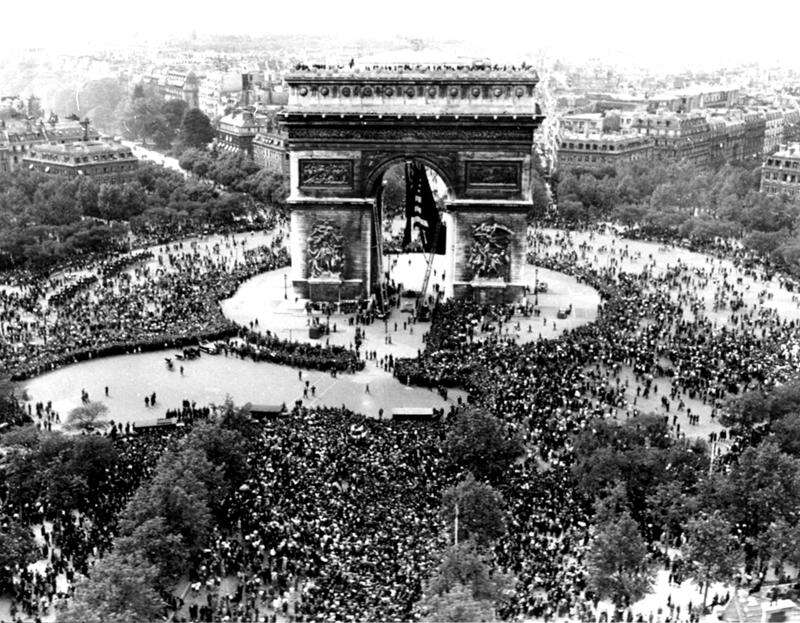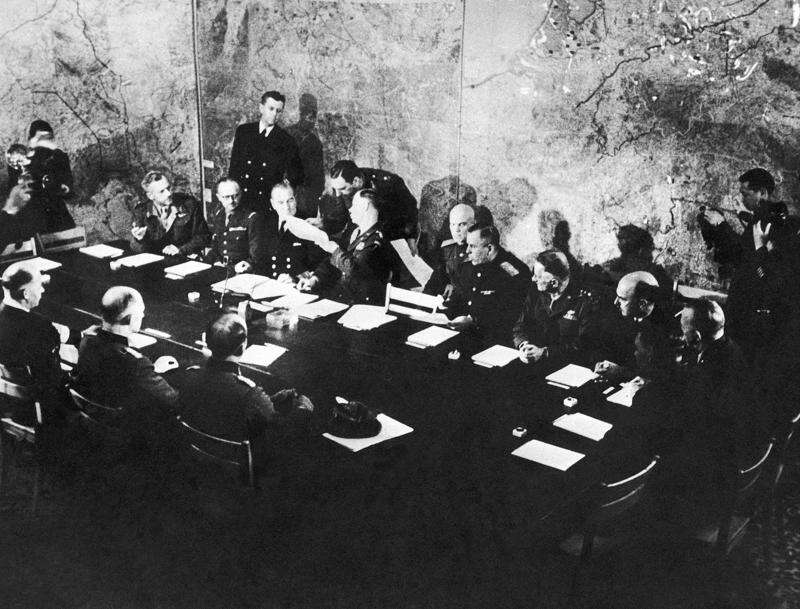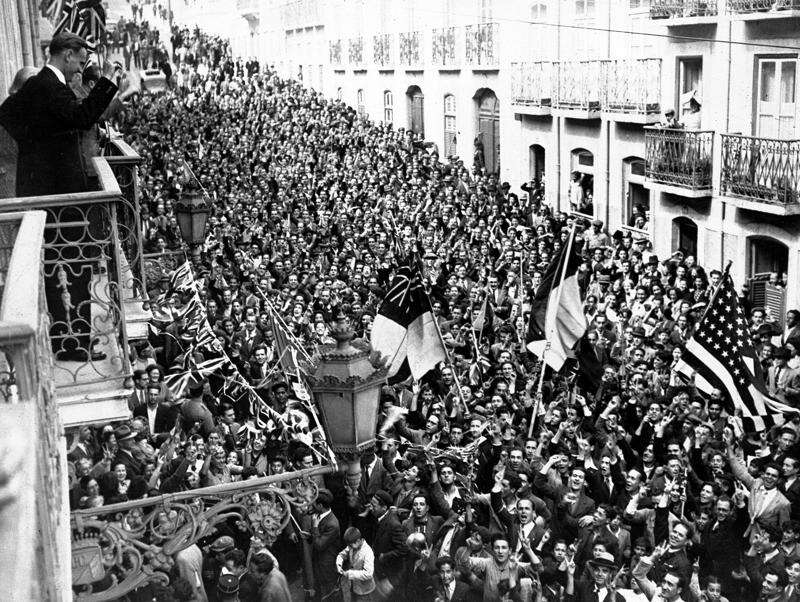Pfc. Clarence K. Ayers of Evansville, Ind., reads the news of V-E Day as newly arrived German prisoners stand of a New York City pier, May 8, 1945. (AP Photo/John Rooney)
PARIS — With quiet moments of memory or military pomp, leaders and ordinary citizens across Europe are marking 70 years since the Nazi defeat and the end of a war that ravaged the continent. But the East-West alliance that vanquished Hitler is deeply divided today.
Russia is celebrating Soviet wartime feats in a ceremony Saturday that is causing diplomatic tensions because of the country's role in Ukraine's conflict. Poland has held a ceremony meant as an alternative to Moscow's.
Paris' milelong Champs Elysees was closed to traffic to make way for a procession of official motorcades and mounted military escorts that ascended the wide boulevard from the Place de la Concorde to the Arc de Triomphe, site of France's Tomb of the Unknown Soldier.
“The victory of May 8th wasn't the supremacy, the domination, of one nation over another. It was the victory of an ideal over a totalitarian ideology,” President Francois Hollande said in a speech before arriving at the giant stone arch.
U.S. secretary of state John Kerry and the U.S. ambassador to France joined French Foreign Minister Laurent Fabius to lay a wreath at the tomb, in a sign of appreciation for the American role in liberating France from German occupation.
Photos taken 70 years ago show massive crowds of Parisians filling the Champs Elysees to celebrate the Nazi surrender, after nearly five years of occupation. May 8 is now a public holiday in France, but relatively few people turned out on the Champs Elysees Friday for the official ceremony.
Reims, the capital of France's champagne wine region where the German surrender was signed, was organizing four days of events to mark the anniversary.
The German capitulation was announced to the world later that day by an Associated Press reporter who defied military censors to get the story out a full day ahead of the competition — an act for which he was reprimanded and fired. Decades later the news agency apologized for how it treated the reporter, Edward Kennedy, and said he had done the right thing.
In Caen, the Normandy town liberated and largely destroyed during the D-Day invasion nearly a year before the surrender, a “Victory Ball” was being held with a big-band playing swing tunes.
Other ceremonies took place around Europe, including in Poland, where President Bronislaw Komorowski was joined by U.N. Secretary General Ban Ki-moon and the presidents of Ukraine and several Central European countries for a ceremony at the site where some of the first shots were fired by Germany against Poland at the start of the war on Sept. 1, 1939.
In Germany, top officials gathered at Berlin's Reichstag parliament building for an hourlong commemoration of the end of the war in Europe.
A crowd in Chicago's Loop celebrate the report of Germany's surrender that spread through the nation on April 28, 1945. Germany actually signed the surrender documents on May 7. (AP Photo)
Parisians march through the Arc de Triomphe jubilantly waving flags of the Allied Nations as they celebrate the end of World War II on May 8, 1945. German military leaders signed an unconditional surrender in Reims, France, on May 7. (AP Photo)
British RAF servicemen and Danish Red Cross girls ride through the streets of Copenhagen, Denmark, May 8, 1945, to celebrate the city's freedom after German troops had been ordered to lay down their arms and surrender to the nearest British troops. (AP Photo/Eddie Worth)
This general view of Times Square, New York, was made at 11 a.m. on May 7, 1945, and shows New Yorkers jamming the streets to cheer the news of the unconditional surrender of Germany. (AP Photo/Harry Harris)
President Harry S. Truman (right center), gestures as he tells newsmen details of surrender of Germany during news conference at the White House in Washington, May 8, 1945 attended by 123 reporters. At top, facing, are (left to right): Gen. G.C. Marshall, Col. Harry Vaughan, J.L. Reinsch, Rep. Joseph Martin, first lady Bess Truman, Rep. John W. McCormack, Mary Margaret Truman, Admiral William D. Leahy, Capt. James K. Vardaman, Secretary of War Henry L. Stimson, speaker of the House Sam Rayburn, Matthew Connally, Secretary of the Treasury Henry Morgenthau, Secretary of the Navy James V. Forrestal, Senate President Protem Kenneth McKellar, Edward McKin, Stephen Larly, Jonathan Daniels, Attorney General Francis Biddle and Secretary of Labor Frances Perkins. (AP Photo)

This is an aerial view of the Arc de Triomphe in Paris on V-E Day, May 7, 1945, shows thousands of French people celebrating the announcement of Germany's unconditional surrender to the Allies. British, American and French servicemen mingled with the crowds who sang and danced throughout the night. (AP Photo/Griffin)
A large crowd of Utrecht citizens gathers in the streets of the Dutch city, on May 7, 1945, to welcome the liberating Allied troops in their hometown. (AP Photo)
A crowd gathers to celebrate V-E Day at Piccadilly Circus in London, England, on May 8, 1945. The statute of Eros in the center of the square has been boarded up throughout the war for protection from bombing. (AP Photo)
British civilians and Allied servicemen and women gather, as part of a huge crowd, along Piccadilly, near London's Piccadilly Circus, May 7, 1945, to celebrate Germany's total surrender. (AP Photo/Leslie Priest)
Shoppers line up for bread on Chelsea's Pimlico Road, London, on V-E Day, May 8, 1945. London's shopkeepers opened their doors for only two hours this morning so Londoner's could buy groceries to last them over the Victory Holiday period. (AP Photo)
A vast crowd assembled in front of Buckingham Palace, London, on V-E Day, May 8, 1945, cheers the Royal Family as they come out on the balcony, center, minutes after the official announcement of Germany's unconditional surrender. From left are: Princess Elizabeth; Queen Elizabeth; King George VI; and Princess Margaret. (AP Photo/Leslie Priest)
Britain's Prime Minister Winston Churchill leaves the House of Commons, London, on V-E Day, May 8, 1945, in a procession of MPs after officially announcing Germany's unconditional surrender. In a spontaneous move, the House is attending a service at nearby St. Margaret's Church to give thanks for peace. (AP Photo)
Sir Gordon Lethem, Governor of British Guiana, announces Germany's unconditional surrender from the balcony of the Public Buildings in Georgetown, British Guiana, on V-E Day, May 8, 1945. (AP Photo)
General Dwight D. Eisenhower holds up a V-for-victory gesture with the two pens used by high ranking German officers in signing the surrender document at the school house in Reims, France on May 7, 1945. Kay Summersby, background left, Eisenhower's chauffeur-secretary, is seen peeking over General Walter Bedell Smith's shoulder. Her face was censored from the official photo taken by T/Sgt. Al Meserlin, Ike's personal photographer. Other officers are not identified. (AP Photo/Al Meserlin)
Staff Sgt. Arthur Moore of Buffalo, N.Y., who was wounded in Belgium, stands on 42nd Street near Grand Central Station in New York Monday, May 7, 1945 as New Yorkers celebrate news of V-E Day, victory over Nazi Germany. (AP Photo)
Looking north from 44th Street, New York's Times Square is packed Monday, May 7, 1945, with crowds celebrating the news of Germany's unconditional surrender in World War II. (AP Photo/Tom Fitzsimmons)
Two men climb a lamppost during nighttime V-E Day celebrations in the West End of London, England, on May 7, 1945. (AP Photo)
The first British troops to land in Denmark were some of our airborne troops, fresh from their race across Germany to link up with the Russians. Welcome on the arrival of our airborne troops in the city in Copenhagen, May 7, 1945. (AP Photo)

Representatives of German and allied nations were present at the Supreme H. Q. War Room in Rheims, France on May 7, 1945, where German delegates surrendered unconditionally to Britain, Russia, and the Untied States. This historic meeting took place in an upstairs room at SHAEF, formerly the College Moderne de Garcons, a schoolroom in Reims. From left side of table left to right are: German Representatives Wilhelm Oxenius, aide to General Alfred Jodl, and General Admiral Hans Georg von Friedeburg. Seated far end right side of table are General Morgan Dep, Cops Shaef, General Francois Sevez, Cofs French Army, Admiral Burrough, allied naval commander, General Smoth Cofs Shaef, General Strong, G-2 Shaef, General Suslaparov, Russian Army, General Carl Spaatz U.S. Air Force, Air Marshal Robb Dep Cof Shaef, General Bull G-3 Shaef, Col. Zenkovitch, aide to Russian General Suslaparov. (AP Photo/Morse)

People crowd into the street outside the U.S. and British Embassies, Lisbon, Portugal, on V-E Day, May 8, 1945. Jubilant crowds celebrated for two days and nights. (AP Photo)
People crowd Times Square at 42nd Street in New York City on May 8, 1945, as the V-E Day celebration continues into the night. The dimout and the brownout of the "Great White Way" have been replaced once more by the bright lights of victory. (AP Photo/Matty Zimmerman)
Britain's Prime Minister Winston Churchill, center, joins the royal family, from left, Princess Elizabeth, Queen Elizabeth, King George VI, and Princess Margaret, on the balcony of Buckingham Palace, London, England, on VE-Day on May 8, 1945. (AP Photo)
Enthusiastic Danish crowds greeted the British column on its arrival in Copenhagen, May 8, 1945. (AP Photo)
After making his public broadcast officially announcing Germany's total surrender, the Prime Minister went to the House of Commons, to make a short address and them moved that the House attend at the church of St. Margaret's Westminster, to give humble and reverent thanks to almighty God for our deliverance from the threat of German domination. The House then rose and followed the Speaker to the church. Prime Minister Winston Churchill, center, in the procession of members of the House leaving the Palace of Westminster for St. Margaret's Church in London, on May 8, 1945. (AP Photo)
A seething mass of humanity jammed itself into Whitehall on VE-Day, to see the premier, his cabinet ministers and chiefs of staff who are to appear on the balcony of the Ministry of Health. A section of the huge crowd gathered in Parliament Square into Whitehall in London on May 8, 1945, as they listened to the premier's broadcast officially announcing Germany's unconditional surrender. (AP Photo)
President Harry S. Truman smiles happily as he announces to the press the complete victory of the Allies over Germany, during a ceremony at the White House in Washington, D.C., May 8, 1945. Seated near the wall behind Truman are, left to right: Elmer Davis, Secretary Henry A. Wallace, Maj. Gen. Philip Fleming, Rep. Joseph Martin, Jr., Gen. George C. Marshall, J. Leonard Reinsch, Col. Harry Vaughan, John Snyder, first lady Bess Truman, Mary Margaret Truman and Secretary of War Henry Stimson. Fred M. Vinson is in the foreground. (AP Photo)
Through streets lined deep with jubilant Danish crowds, British troops enter the city of Copenhagen during V-E Day celebrations on May 11, 1945, after the announcement of Germany's unconditional surrender to the Allies. (AP Photo/Eddie Worth)
President Harry S. Truman sits in front of the microphone holding his speech to the nation announcing the Allied armies won an unconditional surrender from German forces on all fronts in 1945. (AP Photo)
An American soldier, right, hugs an Englishwoman as other U.S. soldiers celebrate the surrender of Germany, May 7, 1945, in London's Piccadilly Circus. (AP Photo)